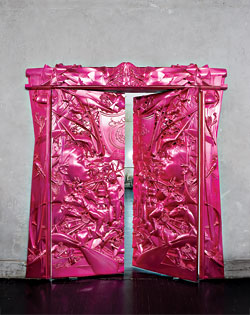
Growing up on a sheep farm in rural Australia, Richard Christiansen was immersed in saturated colors and landscapes that stretched as far as the eye could see. His family were always creative—his mother grew fantastic topiary and planted flower beds of camellias and azaleas that spelled out the property’s name so large it could be read from an airplane. But a severe drought put an end to that part of his childhood; the farm was lost, the china and crystal that had been saved for special occasions sold. “That was a turning point,” Christiansen says. “I promised myself that I would never save anything for a ‘special occasion.’ Every day has to be a special occasion.”
His parents came up with a creative approach to their next farm: They brought in sheep races, boomerang-throwing, and a fake tribe of wandering Aborigines, and made it a kind of “Australian experience” catering to Japanese tourists. A little theater, Christiansen learned, has a lot of selling power.
Now, at the Noho office of his advertising agency Chandelier Creative, the staff has china and crystal for their lunches. There are fresh flowers on the purple piano. Each employee’s desk is different; they are found at flea markets and lacquered black for visual uniformity.
Christiansen had been a creative director at art-book publisher Assouline and Suede magazine before he took out a second mortgage to start Chandelier three and a half years ago. The company moved here in September 2007; the penthouse space had been the showroom of the late fashion designer Giorgio Sant’Angelo, as well as an art studio where Victorian ladies posed nude, a speakeasy, and a makeshift morgue. The space satisfies Christiansen’s desire to make even the workday an event; the work itself calls on the showmanship he learned from his parents. Example: Early on, Christiansen got the chance to pitch the Nordstrom department stores—but at the time he had only three employees. So in order to appear impressively busy and important, he “staged” an office: hired fake staff off Craigslist, rented a space, and furnished it with flea-market tables and rented computers. It worked. Since then, Chandelier’s accounts—in this, his real office—have included the Mandarin Oriental, Parfums Givenchy, Old Navy, Morgans Hotel Group, and Liberty of London.

1. Chesterfield Sofa and Chairs
A Craigslist find. Christiansen had them reupholstered in Chinatown in black latex.
2. Airplanes Models
Christiansen collects the metal versions made in the seventies. One he found at an estate sale in rural Canada, others he buys from a garrulous elderly collector on trips to Paris. “It’s become a ritual,” he says.
3. White Chairs
The upholstery fabric is by Josef Frank, from Liberty of London (one of Chandelier’s clients); the chairs are from Tepper Galleries.

Library Doors
“They were designed at MachineHistories in Los Angeles. They took one year to design and carve. They contain all the things I love: teapots, Muppet Show characters, horses, a kangaroo, a robot, spiders, a serpent, an apple, and, of course, our Chandelier crest.
1. Magenta Helicopter
This and the Porky Pig in the foreground are from an amusement park, via eBay; they were then painted hexachrome magenta at a Brooklyn auto-body shop. Both are still functioning rides.
2. The Horse Lamp
From Swedish designers Front. “My brother saw it in Copenhagen,” says Christiansen. “He asked me if he could use my credit card to buy a ‘nice lamp.’ Six months later, it arrived. Everyone needs a dark horse in their office.”
3. Ronald McDonald Head
One of his designers found it at an Oregon flea market for the clownphobic Christiansen. “We keep it on the piano to remind us to face our fears,” he says.
4. The Walls
When the company moved in, the walls had been freshly painted; Christiansen has been “re-distressing” them. “The lived-in, the worn, the scuffed, the stained, are an antidote to the clinical,” he says.
